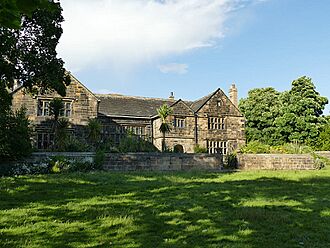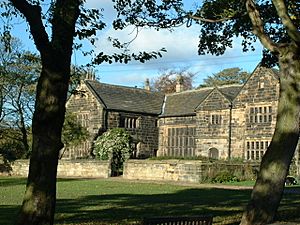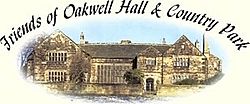Oakwell Hall facts for kids
Quick facts for kids Oakwell Hall |
|
|---|---|
 |
|
| General information | |
| Type | Manor house |
| Architectural style | Elizabethan |
| Location | Nutter Lane, Birstall, Batley, West Yorkshire, England |
| Coordinates | 53°44′24″N 1°40′18″W / 53.7400°N 1.6718°W (grid reference SE2127) |
| Owner | Kirklees Council |
| Grounds | 110 acres (0.45 km2) |
| Design and construction | |
| Main contractor | John Batte |
| Designations | Grade I listed |
Oakwell Hall is an amazing old house from the Elizabethan period. It's located in Birstall, West Yorkshire, England. This special house is a "Grade I listed building," which means it's very important and protected. It sits within beautiful old gardens and a huge country park that covers about 110 acres (that's like 80 football fields!).
The house was built for a man named John Batte. A stone with the year 1583 carved into it probably shows when it was finished. John's father, who was from Halifax, bought the land. He collected rents for the Savile family, who lived nearby at Howley Hall.
Oakwell Hall became famous in books! The author Charlotte Brontë used it as the setting for "Fieldhead" in her novel Shirley. You might also have seen it on TV. It has been used in many shows, like the ITV drama Victoria.
Contents
History of Oakwell Hall
John Batt built Oakwell Hall after his father bought the land. His father worked for the Savile family, who lived at Howley Hall. The hall was built using a type of stone called gritstone. It followed a common design for houses from that time, with a main hall in the middle and two wings on either side.
The main entrance is through a porch and a special hallway called a "screens passage." The stone dated 1583 likely marks the year the house was completed.
Oakwell Hall Today
Oakwell Hall became a public property in 1928. Today, Kirklees Council owns and looks after it. Volunteers from a group called the "Friends of Oakwell Hall" also help out a lot.
The inside of the hall has been carefully restored to look like it did in the late 1600s. This was when the Batt family lived there. Experts studied old records to make sure everything was just right. During this restoration, they found original painted designs on the wooden walls in some rooms, hidden under layers of old paint!
The hall has also been a filming location. For example, the BBC Television series Gunpowder (from 2017) filmed some scenes here.
Inside the Hall
Let's take a peek inside Oakwell Hall and see what life was like long ago!
The Great Hall
The Great Hall used to have two floors. But in the mid-1600s, John Batt's grandson changed it. He removed the ceiling and added a gallery (a walkway) and a huge window. This room was like the main hallway of the house, connecting all the different parts. It was also the center of family life. Important visitors, people who rented land from the Batts, and business people would be welcomed here. It was also used for big gatherings.
Today, the Great Hall is simply furnished. The table is placed at one end of the room, just as it would have been in the late 1600s. The large size of the room was meant to impress everyone who entered.
The Great Parlour
In the early 1600s, the Great Parlour was the most important room. Old records from 1611 show it had the best furniture and the Batt family's map collection. In the 1630s, the Batts added a beautiful plaster ceiling and painted the wooden walls. There's even a painted landscape scene above the fireplace! Most of these original painted panels are still there.
The painting style, called scumbling, made the room feel warm and grand. Not many examples of this kind of decoration still exist today. Later in the 1600s, dining rooms and parlours became popular for eating and entertaining guests privately. The Great Parlour is now set up to show how a stylish and cozy room would have looked in the 1690s.
The Great Parlour Chamber
In 1690, John Batt himself used the Great Parlour Chamber as his bedroom. It even had a garderobe (an old-fashioned toilet) built into the wall. The floor was covered with rush matting, which was common in wealthy homes and made the room warmer than bare floors. The fireplace you see now was added in the 1800s.
It wasn't strange to have a table and chairs in a bedroom back then. Bedrooms were often used for more than just sleeping; people would entertain guests with drinks or play cards there.
The Kitchen
The kitchen was one of the busiest rooms in the house! The lady of the house would oversee the female servants as they prepared food, medicines, and even pot-pourri. There would also be many tradesmen, farm workers, and servants from other important families coming and going. At meal times, the servants would eat together from wooden plates.
When the hall was first built, food might have been cooked over a large fire in the Great Hall. But by 1611, the kitchen had its own separate room in the east wing. The kitchen is separated from the living areas by the "screens passage." The fireplace in the kitchen today was replaced in the 1800s; the original one would have been much wider and larger.
The Kitchen Chamber
This room was where the servants slept and where food was stored. It doesn't have wooden wall panels or a ceiling. Its location, next to the back stairs and above the kitchen, made it easy for servants to get to. Many local houses used their kitchen chambers for storage. In 1611, this room had five large chests for storing grain. Today, it has one big chest and other food storage boxes.
Without a fireplace and with unpaneled walls, it would have been very cold in winter. However, the warmth from the kitchen below would help keep the stored food dry.
The Little Parlour Chamber
Old records from 1611 show that the household had 17 beds of different kinds. There were simple "truckle beds" for servants and grand "tester beds" for family members. Older beds were moved to less important rooms. The Little Parlour Chamber is furnished with older pieces and was used as a "second-best" bedroom. You can see copies of old tapestries hanging on the walls.
In the 1800s, this room was changed when stairs and a passage were added. You can still see the original wooden frame of the walls, showing how they were built with lath and plaster.
The New Parlour
The New Parlour shows what a typical dining room in the 1600s might have looked like. Servants would place food on a side table and then serve it to the family. A "court cupboard" held pewter dishes and plates. There was also a small corner cupboard for spices, which could be locked. The lady of the house kept the key because spices were very valuable back then!
The New Parlour Chamber
Wealthy homes in the 1600s often had rooms for visitors. The New Parlour Chamber is set up as a "second-best" bedroom. It might have been used by a nursemaid and the children she cared for, or by other members of the household. A screen near the doorway helped block drafts from the bed curtains. An attached dressing room or closet displays copies of old costumes.
The warm colors of the wooden walls and bed curtains match the carpet on the table. This was common in richer 17th-century houses. Tables or beds were perfect places to show off a beautiful carpet that was too valuable to walk on.
The Painted Chamber
The Painted Chamber is furnished with new oak furniture that looks like it would have when it was first made (not dark from age). The painted designs on the walls here are larger and less fancy than those in the Great Parlour. These paintings were found under layers of paint and are thought to be from the 1600s.
This room is shown as the mistress's (lady of the house's) bedroom. A small table by the window gets the most light for sewing. The floorboards have been relaid in the style of the 1600s. In 1609, a floor was laid here, costing five shillings and tenpence for seven days of work! The painted walls create a 3D effect, making them look like real wood grain. The "squiggles" were meant to look like walnut wood, which was becoming very popular but was expensive. So, painting was a way to imitate it. The paint was made with linseed oil, and feathers and combs were dragged over it to create the wood grain effect.
The Study
The study is a small room located off the gallery above the Main Hall. An inventory from 1611 shows that Robert Batt, who lived here, owned more than 60 books. This was a lot of books at a time when books were very expensive and few people could read! Robert studied at Oxford University and later became a church leader in Newton Tony.
Exploring the Grounds
Oakwell Hall is surrounded by beautiful grounds that are fun to explore!
A stone statue of a ram stands on the lawn in front of the hall. People say it used to be above the gates of a brewery in Dewsbury.
Formal Gardens
Around the hall, you'll find formal gardens, including a special herb garden. Herbs and flowers were super important for housewives and cooks long ago. They were used to make scented oils, herbal medicines, and, of course, for cooking! Even though Oakwell's herb garden is small, it shows you many different kinds of herbs that were available. There are over 80 types of herbs in the garden, and even more planted among the flowers in the formal gardens behind the hall.
The formal gardens have been restored to look like they did in the 1690s, using plants that were popular back then. The garden has a parterre, which is a fancy garden with patterns made from clipped box hedges and shaped bushes called topiary. The patterns of the hedges were inspired by furniture and plaster designs inside the hall. Even the green color used on the wooden parts of the garden is typical of that time!
Parkland
Oakwell Hall Country Park is the most northern country park in England to be officially recognized. Within its 110 acres, you'll find many different natural areas: woodlands, streams, grassy fields, ponds, and paths for horses. Nature trail markers guide you on walks around the park. Information points tell you about the plants and animals you might see. One path from the park leads to the site of the Battle of Adwalton Moor, and another goes to Red House (which is now closed).
Colliery Field
Colliery Field is a grassy area in the middle of the park. It used to be where waste from Gomersal Colliery (a coal mine) was piled up. The mine closed in the 1970s. The soil here doesn't have many nutrients, so it has been replanted with meadow flowers like red clover, ox-eye daisy, self heal, and yellow rattle. These flowers are full of nectar, which attracts insects, especially bumblebees. This field is sometimes used for historical re-enactments of English Civil War battles, horse shows, and country fairs.
Colliery Pond
Colliery Pond was created when the National Coal Board built a concrete road to help with dumping mine waste. The road is now hidden under the grass and acts like a dam. Water plants like water forget-me-not, bogbean, and purple loosestrife grow here. Many creatures are drawn to the pond, such as toads, moorhens, smooth newts, swan mussels, and different kinds of damselfly and dragonfly.
Nova Meadow
Nova Meadow is a damp area with plants that love moisture, including lady's smock, common tussock grass, meadowsweet, ragged robin, and yellow flag iris. A pond was added in 2003 to attract more wildlife. The southern part of the meadow has grown into scrubland, which is a good home for birds like yellowhammers and linnets. In autumn, it attracts thrushes, fieldfares, and redwings, who come to eat the hawthorn berries.
Nova Wood
Much of Nova Wood was once coppiced (cut back to grow new shoots) to provide wood for the Gomersal Colliery. But the trees have grown back, creating multi-stemmed sessile oaks and birch trees. In spring, Nova Wood is covered in a carpet of bluebells. It's also a home for birds that migrate in summer, like the chiffchaff and blackcap.
Nova Beck
Nova Beck is one of two streams that flow through Oakwell, both running from north to south. Nova Beck forms the western edge of Nova Wood and flows through areas with many wildflowers. Many of the plants here, such as yellow archangel, wood anemone, and wild garlic, are signs of very old woodlands. You'll also find lots of hard shield fern, red campion, and herb bennet.
Oakwell Beck
Oakwell Beck winds its way along the southern edge of Colliery Field. Along this stream, you can see exposed coal seams and even fossilized "ripples" from ancient seas! It doesn't have as many different plants as Nova Beck, but in spring and early summer, the wooded areas are thick with wild garlic, lesser celandine, and bistort. You might also spot patches of lords and ladies in shadier spots. Ash, alder, and willow trees make up most of the tree cover and provide a home for tawny owls.
The Ghost Story
Oakwell Hall has its own famous ghost story! It's about a young man named William Batt, who was 25 years old and lived at Oakwell with his widowed mother, Elizabeth.
The story was written down by Mrs. Gaskell in her book Life of Charlotte Brontë (from 1857). She wrote:
"Captain Batt was believed to be far away; his family was at Oakwell; when in the dusk on winter evening, he came stalking along the lane, through the hall and up the stairs, into his own room, where he vanished. He has been killed in duel in London that very same afternoon of December 9th 1684."
The legend says that he left a bloody footprint in a bedroom. However, historical records show that William Batt was in London on December 9, 1684, where he borrowed money. A local writer named Oliver Heywood wrote in his diary that William died "in sport" or was "slain by Mr Gream at Barne near London." William Batt was buried in Birstall on December 30, 1684.
The Brontë Connection
In the 1800s, Oakwell Hall was used as a school for girls. Charlotte Brontë's close friend, Ellen Nussey, lived in Birstall. Ellen likely brought Charlotte to see the school at Oakwell because Charlotte was thinking about starting a school with her sisters in Haworth.
Charlotte Brontë visited the hall and was so inspired that she used it as the setting for the manor house, "Fieldhead," in her famous novel Shirley.
Charlotte Brontë described it like this in her 1849 novel: "If Fieldhead had few other merits as a building, it might at least be termed picturesque: its irregular architecture, and the grey and mossy colouring communicated by time, gave it a just claim to this epithet. The old latticed windows, the stone porch, the walls, the roof, the chimney-stacks, were rich in crayon touches and sepia lights and shades. The trees behind were fine, bold, and spreading; the cedar on the lawn in front was grand, and the granite urns on the garden wall, the fretted arch of the gateway, were, for an artist, as the very desire of the eye."
Elizabeth Gaskell also described the house when talking about Shirley in her 1857 book, The Life of Charlotte Brontë: "From the ‘Bloody Lane’, overshadowed by trees, you come into the field in which Oakwell Hall is situated... The enclosure in front, half court, half garden; the panelled hall, with the gallery opening into the bed-chambers running round; the barbarous peach-coloured drawing-room; the bright look-out through the garden-door upon the grassy lawns and terraces behind, where the soft-hued pigeons still love to coo and strut in the sun, – are described in Shirley. The scenery of that fiction lies close around; the real events which suggested it took place in the immediate neighbourhood."
Oakwell Hall is also a starting point for the Brontë Way. This is a 43-mile long-distance walking path that goes around Bradford to Haworth. It then crosses the South Pennines and continues to Gawthorpe Hall in Lancashire.
Friends of Oakwell Hall
The "Friends of Oakwell Hall and Country Park" group was started in 1988. They are a group of volunteers who help support the old manor house and its 110-acre country park. The Friends work closely with the Head Ranger and staff at Oakwell, helping both inside and outside the hall.
Archaeology at Oakwell
Archaeological digs have been carried out at Oakwell Hall by WYAS (West Yorkshire Archaeology Service). They've had help from 'South Leeds Archaeology,' a community group. In May 2008, they dug up the lawn in front of the hall. They found holes where posts used to be, likely from a farm that was on the site but disappeared from maps between 1834 and 1844.



